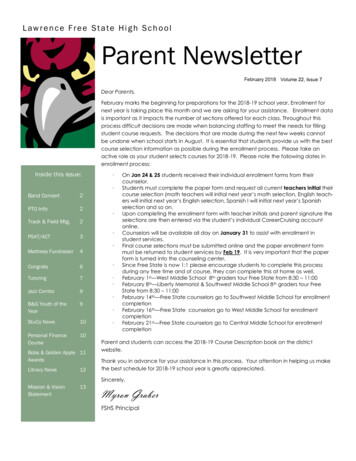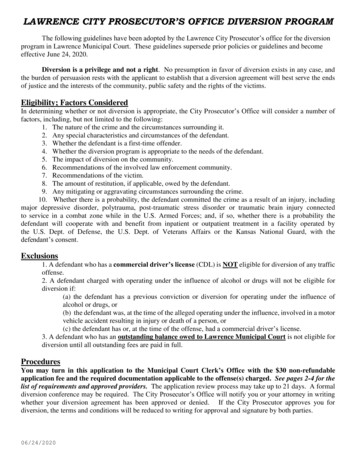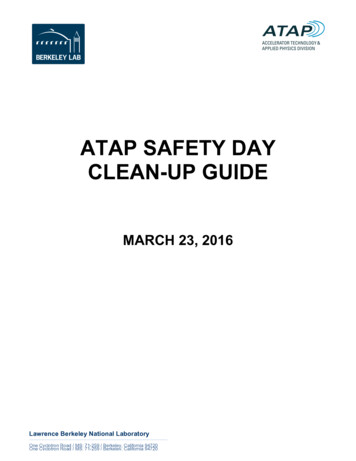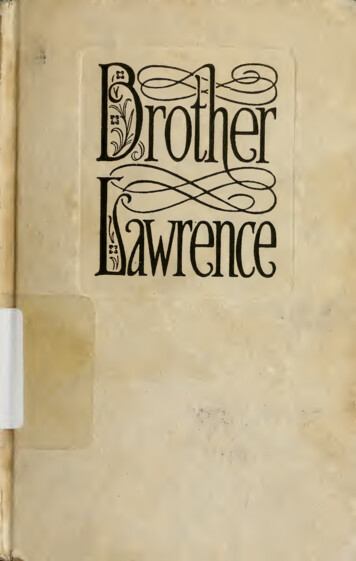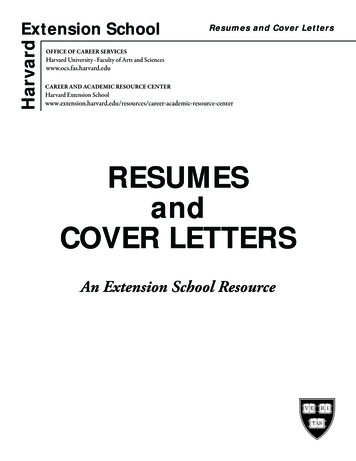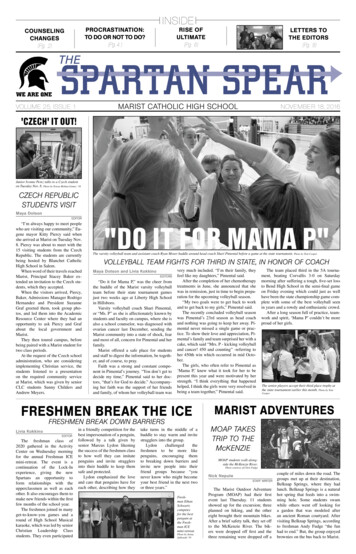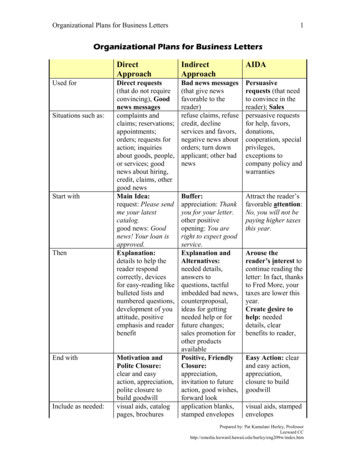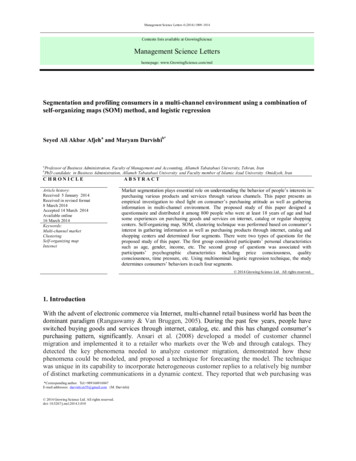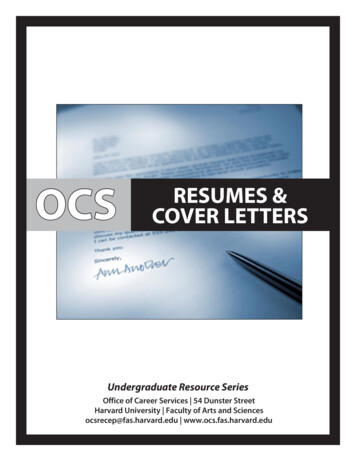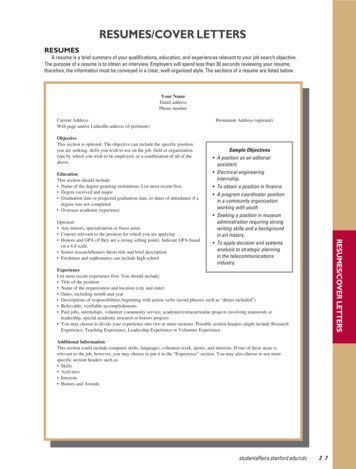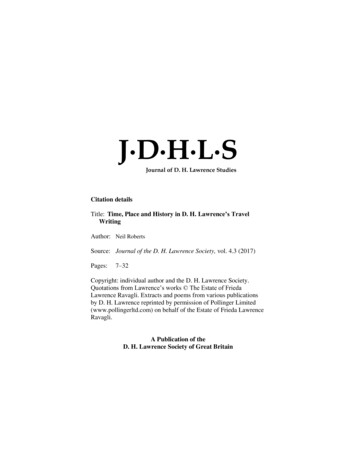
Transcription
J D H L SJournal of D. H. Lawrence StudiesCitation detailsTitle: Time, Place and History in D. H. Lawrence’s TravelWritingAuthor: Neil RobertsSource: Journal of the D. H. Lawrence Society, vol. 4.3 (2017)Pages:7‒32Copyright: individual author and the D. H. Lawrence Society.Quotations from Lawrence’s works The Estate of FriedaLawrence Ravagli. Extracts and poems from various publicationsby D. H. Lawrence reprinted by permission of Pollinger Limited(www.pollingerltd.com) on behalf of the Estate of Frieda LawrenceRavagli.A Publication of theD. H. Lawrence Society of Great Britain
JDHLS 4.3 (2017)7TIME, PLACE AND HISTORY IN D. H. LAWRENCE’STRAVEL WRITINGNEIL ROBERTSLawrence largely pre-empted the terms in which his travel writingwas to be discussed by coining the phrase “spirit of place”, whichhe used first in Studies in Classic American Literature (serialised in1918‒19), and repeated in Sea and Sardinia (1921), England, MyEngland (1922), Kangaroo (1923), St. Mawr (1925) and ThePlumed Serpent (1926). Place is an ideological concept forLawrence because it insists on diversity, resisting the homogenisingdrive of modernity. In Sea and Sardinia he writes, “In the end thestrange, sinister spirit of place, so diverse and so adverse indiffering places, will smash our mechanical oneness intosmithereens” (SS 57) and in St. Mawr, less triumphally, “the crude,half-created spirit of place, like some serpent-bird forever attackingman, in a hatred of man’s onward-struggle towards furthercreation” (SM 150). In The Plumed Serpent he goes so far as toidentify the spirit of place with the culture of pre-conquest Mexico,suggesting a power that is greater than and impervious to time andhistory: “the great folds of the dragon of the Aztecs, the dragon ofthe Toltecs winding around one and weighing down the soul”(PS 50).A strong sense of place, above all of his native region, is ofcourse a major feature of the fiction Lawrence had written beforehe formulated the concept of “spirit of place”. But, at least in themore mature of these works, the representation of place is deeplyhistoricised: consider the openings of Sons and Lovers (1913) andThe Rainbow (1915). Sometimes in his travel writing he appears tobe constructing place as an ahistorical or trans-historical force, asfor example when he describes Sardinia as a place of “remote,ungrappled hills rising darkly, standing outside of life” where his
8Neil Roberts, D. H. Lawrence’s Travel Writingsoul thrills to “the frost among the tangled, still savage bushes”(SS 135, 117). Its people are correspondingly, unlike otherEuropeans, still “hardy” and “indomitable”, they have never been“subdued” by foreign powers and live “outside the circuit ofcivilisation” (SS 63, 9). But his travel writing is richest when hissense of place is charged by a historical perspective, above all theimpact of modernity on what are still in many ways peasantsocieties.In contrast to other places that he wrote about, Lawrence spentonly a week in Sardinia. His invariably vivid sketches of itsinhabitants were based on single meetings. But even here herealised that the natives were not completely exempt from theeffects of time and modernity. In Mandas he meets a group ofrailway workers, one of whom bursts out with: “At Mandas onedoes nothing. At Mandas one goes to bed when it’s dark, like achicken. At Mandas one walks down the road like a pig that isgoing nowhere. At Mandas a goat understands more than theinhabitants understand. At Mandas one needs Socialism” (SS 79).In his other travel writing, from his first sketches in Germany in1912 to the narratives of life in Oaxaca in 1924, he gave us a seriesof portraits of people whose lives, like those of the Morels andBrangwens, were in the grip of historical change.In Twilight in Italy (1916) there is a potential novel in the figureof the Lawrences’ landlord in Gargnano, Signor Pietro di Paoli:a little, shrivelled man, with close-cropped grey hair on hisskull, and a protruding jaw, which, with his gesticulations,always makes me think of an ancient, aristocratic monkey. TheSignore is a gentleman, and the last, shrivelled representative ofhis race He loves to speak French, because then he feels grand. Hehas a queer, naïve, ancient passion to be grand. As the remainsof an impoverished family, he is not much better than a well-todo peasant. (TI 114)
JDHLS 4.3 (2017)9Signor di Paoli’s every gesture signifies the historical change thathas demeaned his status. Such a figure could easily be lampoonedas an effete, pathetic snob, but Lawrence’s portrayal is deeplysympathetic. The word “naïve” is always a marker of sympathy inLawrence, and this is a strange and distinctive naïvety, being a signof Pietro’s breeding. This quality is dramatically portrayed as heremoves the malfunctioning spring on his door: “a grey, shaky,highly-bred little gentleman, standing on a chair with a long screwdriver, whilst his wife stood behind him, her hands half-raised tocatch him if he should fall” (TI 122). His origins are not those of aman who would have to fix his own door. He strives to maintain hisdignity and even his manhood in this reduced condition, butdepends on his wife. She is also vividly brought before us togetherwith speculation about their relationship: “She subdued her flameof life to the little padrone She supported him with her flame .But she did not believe in him”.In the later chapters of Twilight in Italy ‒ written, perhapssignificantly, after the outbreak of war ‒ the burden of history ismuch heavier. As Stefania Michelucci has written, these essays are“characterized by an increasingly sombre tone which seems to issuefrom Lawrence’s awareness that the uncontaminated nature of thelake and mountains surrounding it already belong to the past”.1 Thedominant theme of these essays is the economic necessity ofemigration ‒ temporary or permanent ‒ to America. Lawrence’scomparative distance from the events he narrates in these chaptersmay also account for a marked difference in mode. The first threechapters, ‘The Spinner and the Monks’, ‘The Lemon Gardens’ and‘The Theatre’, are revisions of sketches that he had written on thespot in 1913. Their mode, epitomised by the incident of Signor diPaoli fixing the door, is one of vivid, detailed observation. The laterchapters by contrast, including those set in San Gaudenzio, seem tohave been written afresh in 1915, two years after Lawrence’sresidence there. The mode in which he writes is much morespeculative. When Lawrence writes of Paolo and Maria Fiori, “Henever opposed or contradicted her, but stayed apart . But
10Neil Roberts, D. H. Lawrence’s Travel Writingsometimes Paolo went into a rage, and then Maria, everybody, wasafraid”, or “fairly often on a Sunday Paolo got drunk”, one wouldnever guess that the Lawrences spent a mere eight days at SanGaudenzio (TI 162, 163).Indeed, one could go so far as to describe the mode in whichLawrence describes the Fiori family as allegorical. Paolo representsthe immemorial peasant life. He is fatalistic about physical hardshipand restricted horizons. He has a quasi-religious respect for those(including the Lawrences) whom he considers “Signoria”. Thisrespect is often misdirected, but Lawrence approves of it inprinciple. The couple are conceived as opposites. Paolo has “asubtle intelligence in feeling” but “the mind was unintelligent”;Maria “was much sharper and more adaptable to the ways of theworld” but also “much coarser, more vulgar” (TI 157‒8). Lawrencemay have drawn on this contrast between the conservative man andthe outward-looking woman when imagining the male and femaleBrangwens in the early pages of The Rainbow.In their first child, Giovanni, “the fusion of the parents wasperfect” (TI 157). He was “beautiful, gentle, and courtly like Paolo,but warm, like Maria . He stood straight and tall, and seemed tolook into the far distance with his clear grey eyes. Yet also he couldlook at one and touch one with his look, he could meet one”(TI 158). The antitheses that distinguish Paolo and Maria from eachother, in Giovanni form a harmonious whole. He represents theideal potential of their marriage ‒ the potential of their elements,untouched by history.In the second brother Marco, however, this harmony has beenbroken. “[T]here was some discrepancy in him. He was not unified,he had no identity . There was such a split, a contrariety in hissoul, one part reacting against the other” (TI 158). The allegoricalsignificance of this difference emerges in the sentence, “It waswhen Marco was a baby that Paolo had gone to America”. For theseItalian peasants, as we shall see, the significance of going toAmerica ‒ indeed the very meaning of America ‒ was verydifferent from what it was soon to be for Lawrence himself.
JDHLS 4.3 (2017)11America is the sign of the historical forces, the forces of modernity,that are undermining the old peasant order. According to Lawrence,it was Maria who motivated Paolo’s American exile to work in thegold mines. “She had departed from the old static conception”(TI 159). Though he spent five years in California, Paolo “neverreally left San Gaudenzio” (TI 163). His soul, polarised to thepeasant way of life, is impervious to modernity. Paradoxically, itwas Maria who “suffered more bitterly” (TI 163): in a curious turnof phrase (given that she was the motivator), “Paolo had desertedher, she had been betrayed to other men for five years” (TI 164).This twist on the idea of sexual betrayal may of course reflectLawrence’s feelings about Frieda and Ernest Weekley.The rumours of Maria’s infidelity during Paolo’s absence allowLawrence to write, about their third child, “I could never believeFelicina was Paolo’s child. She was an unprepossessing little girl,affected, cold, selfish, foolish” (TI 164). Although Lawrenceacknowledges that Paolo and Maria were “warm and natural” toher, he asserts that “they did not love her in their very souls, shewas the fruit of ash to them”. Maria insists that Felicina was born ayear after Paolo returned from America, but Lawrence’s insinuationsuits his allegorical scheme of progressive disintegration, of whichAmerica is the sign. In Felicina evidently the peasant virtues thatare preserved in Paolo and animate Giovanni are extinct.By the time of the Lawrences’ visit even Giovanni, theharmonious offspring of Paolo and Maria, “would go to America .The world was not San Gaudenzio to Giovanni” (TI 164).According to Paul Eggert’s researches he did not go to America: heonce planned to go to Australia but “remained a peasant farmer inSan Gaudenzio” (TI 290). We can see the schematic hand ofLawrence’s allegory here. While the Lawrences were in SanGaudenzio they were accompanied by Tony Cyriax, a friend of theGarnetts, who stayed there for several months and wrote her ownaccount, Among Italian Peasants, published in 1919, three yearsafter Twilight in Italy. Cyriax got to know the family much moreintimately than Lawrence, but her account of the characters of
12Neil Roberts, D. H. Lawrence’s Travel WritingPaolo, Maria, Giovanni, Marco and Felicina, and of the familydynamics is very similar to his. She does not, however, link theprogressive degeneration of the family’s relationships to Paolo’sresidence in America. Lawrence has made the same observations asCyriax, but given them an historical significance.In Mornings in Mexico (1927) ‒ in the part of that book whichactually is about Mexico, the first four chapters set in Oaxaca ‒Lawrence’s awareness of the effect of historical change comes upagainst and triumphs over his predilection for the essential andunchangeable otherness of foreign people. These chapters are heldtogether by a tender and moving portrayal of the servant or “mozo”whom the Lawrences inherited with their house in Oaxaca, theyoung Zapotec Indian Rosalino. Lawrence characterises MexicanIndians with reference to the Aztec myth of the goddessTonacaciuatl who gave birth to “a razor-edged knife of blackishgreen flint” (actually obsidian; MM 35). He accounts for theirdisconcerting and uncommunicative otherness by being “sons ofincomprehensible mothers” with “stiff little bodies as taut and askeen as knives of obsidian” (MM 36). Rosalino he concedes to be alittle different, with “a certain sensitiveness and aloneness, as if hewere a mother’s boy” (MM 35): the first sign of his kinship with theauthor. At first Lawrence thinks this might because he has “adistant strain of other Indian blood, not Zapotec” (in manuscript herevealingly wrote “Spanish blood”) but this lazy racial thinking issoon overturned.Later in the essay Lawrence becomes exasperated becauseRosalino obstinately refuses to help carry furniture andincomprehensibly alternates between happy contentedness andgloomy homesickness for his native village. “The Indian gloom,which settles on them like a black marsh-fog, had settled on him .The flint knife” (MM 41‒2). This sounds, as Lawrence does attimes, like the complacently confident colonialist explanation of thenative, which really explains nothing. But Lawrence is actuallysetting himself up for a lesson. Lawrence visited Mexico only a fewyears after the supposed end of the Mexican revolution, and
JDHLS 4.3 (2017)13sporadic political violence continued. Pancho Villa wasassassinated only a few days after the end of Lawrence’s first visit,in July 1923; he left Mexico for the second time, in December ofthat year, via the port of Veracruz just before it was occupied by therebel army of Alfonso de la Huerta. On the train on whichLawrence and Frieda travelled to Oaxaca in November 1924 therewere twenty soldiers to guard forty passengers (5L 166).At the end of ‘The Mozo’ Lawrence discovers that Rosalino’svillage had been caught up in de la Huerta’s revolt, when the rebelstried to press men into military service. Rosalino refused, and as aconsequence “the recruiting soldiers beat him with the butt of theirrifles till he lay unconscious, apparently dead” (MM 44). He stillsuffers from an injured back. This, Lawrence realises, “explains hisfear of furniture-carrying, and his fear of being ‘caught’”. In themost revealing moment in this sketch Lawrence writes, “He is oneof those, like myself, who have a horror of serving in a mass ofmen” (MM 43). Echoes of his Cornwall experience reverberate,seven years later in remote Oaxaca: as he wrote from HigherTregerthen in June 1916, in response to one of his military medicalinspections, “this terrible glamour of camaraderie is adecadence, a degradation . I could not bear it ‒ I should die in aweek if they made me a soldier” (2L 618).For all this acute awareness of the effect of history on his Italianand Mexican subjects, Lawrence the narrator of these essaysappears exempt from history. He is the privileged traveller with theworld at his disposal, free to observe and pass on. In this respect heis the typical British travel writer of the early twentieth century, likeNorman Douglas in Old Calabria (1915) or Aldous Huxley inAlong the Road (1925). In Twilight in Italy his social position is animportant element in the narrative. He and Frieda were desperatelypoor, living in Gargnano partly because they could not afford Rivaon the Austrian side of the border. But once settled in Gargnano theminer’s son and former elementary school-teacher is a “signore”, agentleman. Signor di Paolo considers his request to Lawrence tohelp him with his faulty door-spring “an affair of gentlemen”
14Neil Roberts, D. H. Lawrence’s Travel Writing(TI 123). When Lawrence goes to the theatre he has to “make bowsall round” to the village elite who like him occupy boxes (TI 133);when he stays up the hill in San Gaudenzio Maria tries to keep himaway from disreputable characters: “They are not people for you,Signore. You don’t know them” (TI 173). As Lawrence wrote in aletter, “I am a howling gentleman and swell here” and the Germanlandlady of a hotel was “fearfully honoured at the thought ofcoming to afternoon coffee” (1L 466). His absence from theperformance of Hamlet would make it “a bitter occasion” to EnricoPersevalli, the leader of the acting troupe (TI 142). This is the manwhose London acquaintances were only recently describing him inthis style: “a very ‘everyday young man’, with a small, droopingmoustache, carefully brushed hair and heavy clumpy boots”, as ifhe were Leonard Bast in Forster’s Howards End.2 (Leonard Bastalso has a “drooping moustache”: perhaps this was a classstereotype in Edwardian England.)3 Lawrence enjoys the samefreedom and social status in Sea and Sardinia and of course inMornings in Mexico, where he and Frieda occupy five large roomsaround a courtyard and employ a servant. Above all, he is free toleave or to stay. In ‘The Return Journey’, the final essay in Twilightin Italy, which is about Lawrence’s second visit to Italy inSeptember 1913, he narrates his meeting with a young man fromStreatham (not far from Croydon where Lawrence had been aschoolteacher less than two years earlier), who has exhaustedhimself by packing as much walking as possible into his shortholiday. Later Lawrence thinks about him on his way home andreflects, “Thank God I need not go home: never, perhaps” (TI 218).On this journey he is even able to disguise his identity, just becausehe feels like it. At a place where he stops for tea he pretends to thetwo old ladies who run it that he is the son of an Austrian doctor“walking for my pleasure through the countries of Europe”(TI 208). He explains that he says this because “I did not want to bemyself” (TI 209): the ultimate freedom of the unencumberedtraveller.
JDHLS 4.3 (2017)15Lawrence wrote three travel books about Italy and it is animportant setting in two of his novels. This is not surprising giventhat he spent a total of about five years in the country. His elevenmonths in Mexico resulted in a novel set entirely in the country, thesketches in Mornings in Mexico, and one of his most importantshort stories, ‘The Woman Who Rode Away’ (1925). He wrote twonovels set in Australia, a country where he lived for only threemonths. By contrast, nearly two years’ residence in Cornwallproduced only two short pieces of writing set in the county: thirtypages of Kangaroo (1923) and the fifteen-page story ‘Samson andDelilah’ (1917).4However, the time that Lawrence spent in Cornwall was just asformative as his periods of residence abroad. The critical point Iwant to make about it is that his experience while in Cornwall couldnot have been more different from that of the free, privilegedtraveller who narrates his travel books. That persona is not ofcourse an entirely accurate representation of the Lawrence wholived in Italy and Mexico. He did, as a matter of fact, have to gohome from Italy because of Frieda’s distress about her children. Hefinally left Mexico because of a severe breakdown in his health,which he blamed on living in Oaxaca, and he was so sick that hewas nearly refused entry into the United States. Life at the place heloved most of all, his ranch in New Mexico, became too harsh forhim, especially in winter, though he never gave up dreaming ofreturning. But none of these constraints compared in severity to theshackles that history imposed on him between 1915 and the end ofthe war, most of which time he was living in Cornwall. For the firsttime we see a Lawrence who seems defeated by history, who seeksretreat and isolation rather than engagement. Although he hadproposed the idea of Rananim, the ideal community of a smallnumber of like-minded people, some time earlier, it was inCornwall that it came to dominate his thinking about the future, andit was in Cornwall, thinking about America, that he began todevelop the idea of “spirit of place”.
16Neil Roberts, D. H. Lawrence’s Travel Writing‘The Nightmare’ chapter of Kangaroo is unusual in Lawrence,in being an example of formal analepsis, or retrospective narrative.Perhaps the closest other instance is ‘The Industrial Magnate’chapter of Women in Love (1920), which is also an account of, inLawrence’s opinion, a disintegrative historical process, and perhapsnot coincidentally was written in Cornwall. Both analepsis and itsopposite prolepsis, or anticipatory narrative, run counter to theusual spirit in which Lawrence writes, because they close offpossibility. Prolepsis tells us in advance what the outcome of anarrative will be, as when Forster writes early in Where AngelsFear to Tread (1905), “It was in this house that the brief andinevitable tragedy of Lilia’s married life took place”.5 In the case ofanaleptic or retrospective narrative we already know the outcomebefore it is narrated. This is incompatible with Lawrence’sconception of the novel as a “thought-adventure” (ironically it is in‘The Nightmare’ chapter itself that he calls Somers “a thoughtadventurer” [K 238]) in which he is genuinely uncertain how thenarrative will develop, as when he began Women in Love in 1916and wrote, “I have begun a new novel: a thing that is a stranger tome even as I write it. I don’t know what the end will be” (2L 604).He probably felt like this about Kangaroo as a whole, especiallyabout Somers’s involvement with the Diggers, but he cannot havefelt it about ‘The Nightmare’ chapter, in which he is revisiting thephase of his life when history pressed him most severely, and heknew all too well what the end would be.The chapter is full of statements that frame and close off thenarrative with knowledge both of the historical outcome and ofLawrence’s personal history:Awful years—’16, ’17, ’18, ’19—the years when the damagewas done. The years when the world lost its real manhood.(K 213)It was in 1915 the old world ended. In the winter of 19151916 the spirit of the old London collapsed . The integrity of
JDHLS 4.3 (2017)17London collapsed, and the genuine debasement began, theunspeakable baseness of the press and the public voice, the reignof that bloated ignominy, John Bull.No man who has really consciously lived through this canbelieve again absolutely in democracy. (K 216)But it was not till afterwards that he learned that the watchershad lain behind the stone fences, to hear what he and Harrietttalked about. (K 218)The English soul went under, in the war, and as a conscious,proud, adventurous, self-responsible soul, it was lost. (K 222)Writing like this is the consequence of Lawrence being, if notdefeated, then uniquely constrained by a force that he could at bestpassively resist. The chapter is prompted by the fear that Somersfeels in the streets of Sydney after his penultimate, menacingencounter with Kangaroo. Somers’s refusal of engagement, thenovel’s open-endedness, Somers and Harriett leaving Australia“like broken attachments” (K 358) are counterpointed with theconditions that entrapped Somers and Lawrence during the war.Ottoline Morrell honourably excused Lawrence’s vitriolicexcesses to Bertrand Russell in these terms: “He is of course reallyin the Power of the Authorities in a way we of the upper classes arenot”.6 He was not the only person of working-class origins to bepersecuted because of his resistance to the war, but he was the onlyone to have written a great novel which was banned because, in thewords of one reviewer, “A thing like The Rainbow has no right toexist in the wind of war”.7 William Hazlitt wrote, in mitigation ofWordsworth’s sourness of temper and narrowness of mind, “Tohave produced works of genius, and to find them neglected ortreated with scorn, is one of the heaviest trials of human patience”.8If this excused Wordsworth’s less pleasing characteristics, howmuch more mitigation could Lawrence claim in 1916! Lawrencewent to Cornwall to a large extent because he could not afford to
18Neil Roberts, D. H. Lawrence’s Travel Writinglive anywhere else. He was poor because The Rainbow had beenbanned and it was consequently difficult for him to publishanything else. And the banning of The Rainbow had been mademuch more likely by the militaristic and anti-individualisticatmosphere in which it was published. In other words, it waslargely because of the war and “the Power of the Authorities” thatLawrence was in Cornwall in the first place.9 His eventualexpulsion, given his German wife, outspoken anti-war views andunconventional friends, was equally over-determined.But there is another narrative of Lawrence’s time in Cornwall,the one told in his letters, and not surprisingly time and historyfigure rather differently in this story told without hindsight.Lawrence initially thought of Cornwall as the first step towardsAmerica, specifically Florida. Florida was never a very real place inLawrence’s imagination, as New Mexico was to be when he waslater invited by Mabel Luhan. Florida is little more than anothername for the ideal community of Rananim, though Lawrenceincreasingly felt that this community could not be established inEngland. His early letters about his move to Cornwall are full of arather feverish hope for a new world: “Let us all live together andcreate a new world”, “we begin the new life in Cornwall”, “inCornwall and Florida; the germ of a new era”, and, on the day ofhis arrival in Porthcothan, “This is the first move to Florida. Herealready one feels a good peace and a good silence, and a freedom tolove and to create a new life” (2L 482, 487, 489, 491). On the sameday he answers the question, “Is there a Florida?”: “There is aFlorida to be ‒ it must be so . Here one stands on tiptoe, ready toleap off” (2L 492).There are a number of striking features of these letters. One thatis most relevant to my theme is their strong orientation to a future.Another is that “Florida” is merely a name for this future. Thefuture is not a temporal entity determined by the past and present.On the contrary, it is the repudiation of the past, at least of thepersonal and historical past, and it has to be willed: “There is aFlorida to be ‒ it must be so” (2L 492). Immediately before moving
JDHLS 4.3 (2017)19to Cornwall, when Lawrence was staying with his sister inDerbyshire, he wrote:One’s people are the past ‒ pure, without mitigation. And it is sohard to get to the future: and one must look to the future: onemust create the future. That is why we go to Florida: a new life,a new beginning: the inception of a new epoch. (2L 488)Cornwall figures as a prelude to ‒ and, as we shall see eventually,an alternative to ‒ Florida both temporally and spatially: it is as ifLawrence imagines himself literally “leap[ing] off” the Cornishcoast to cross the Atlantic (2L 492). Throughout these letters, andeven more strongly when Lawrence moved westward to Zennor,one hears a distinctly millenarian note ‒ the “new heaven and newearth” of the Book of Revelation (21.1). The abolition of the secularworld in John’s vision is the obvious model for Lawrence’srepudiation of historical reality.Although Lawrence’s writing in the first weeks of his residencein Cornwall is so resolutely oriented to the future, this temporalityis complicated by a strong sense of the past: not, however, thepersonal and historical past that he has repudiated. “I like Cornwallvery much: it is so uncivilised, unchristianised . It is always KingArthur and Tristan for me . I am very fond of that pre-christianflicker of civilisation. But I hate Malory: I hate the Grail andchivalry ‒ lies” (2L 496). This is not an historical but a mythicalpast, derived more from Lawrence’s earlier reading than from directexperience of his environment, and one that he is careful to separatefrom its Christianised elements, which belong to history. Again, “itbelongs still to the days before Christianity, the days of the Druids,or of desolate Celtic magic and conjuring . Here I think my lifebegins again ‒ one is free” (2L 493). This is what the anthropologistMircea Eliade calls “illud tempus”, the mythical past which is alsoeternally present.10 In contrast to the imprisoning historical andpersonal past it leaves him free to “begin again” ‒ it is consonant
20Neil Roberts, D. H. Lawrence’s Travel Writingwith the equally transcendent millenarian future that pervades theseletters.However, Lawrence had already made travel to Floridaimpossible, at least in the near future. At this stage in the war menwere required to “attest” their willingness to be conscripted, byundergoing a medical examination. The Lawrences had passports,but to be free to leave the country he had to attest in the almostcertain knowledge that he would be exempted. On 11 December1915 he went to a recruiting station at Battersea Town Hall but“hated it so much, after waiting nearly two hours, that I cameaway” (2L 474). He felt that it was “vile and false and degrading,such an utter travesty of action on my part, waiting even to beattested that I might be rejected”. After this he felt that he had“triumphed . It is only the immediate present which frightens meand bullies me. In the long run, I have the victory”. Perhaps in thelong run he did have the victory ‒ after all, his work is still beingread and discussed a hundred years later. But, as Mark KinkeadWeekes says, Lawrence’s failure to emigrate to America in 1915“was a turning-point which might have made his life verydifferent”.11 And, of course, his work. At this moment Lawrencewas in what we might call a classic Catch-22. To “attest” hiswillingness to do something his whole self revolted from would beto submit to “the immediate present which frightens and bulliesme” (2L 474) ‒ but only by doing so could he escape to America.He feels “triumph” in his refusal to submit, but its consequence isthat, for the rest of the war ‒ for another three years ‒ he remainsvulnerable to the bullying powers.A mere three weeks later he was writing from Cornwall: “I mustown to you, that I am beaten” (2L 500). This change of feelingmight have been the consequence of the serious illness that hesuffered at the beginning of his residence at Porthcothan, combinedwith a belated realisation of the consequ
Lawrence’s feelings about Frieda and Ernest Weekley. The rumours of Maria’s infidelity during Paolo’s absence allow Lawrence to write, about their third child, “I could never believe Felicina was Paolo’s child. She was an unprepossessing little girl, affected, cold, selfi

